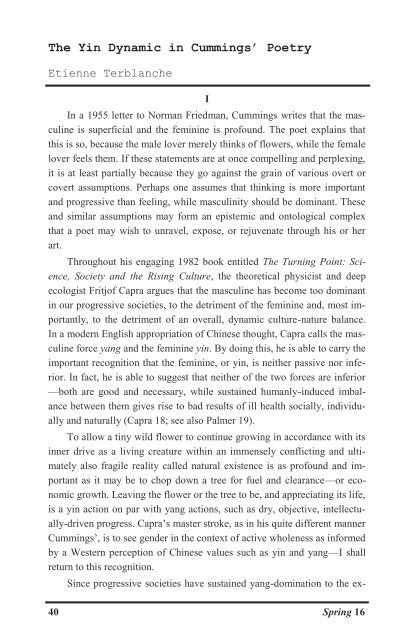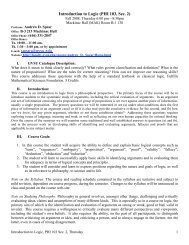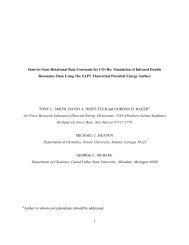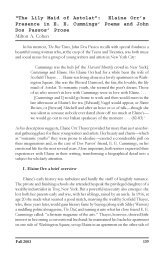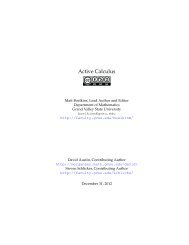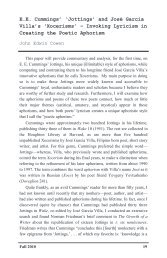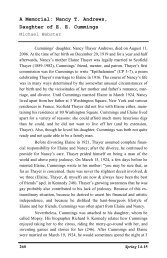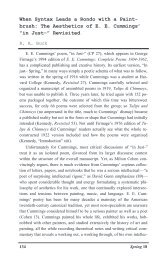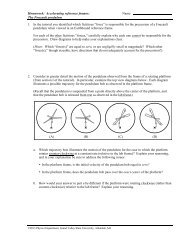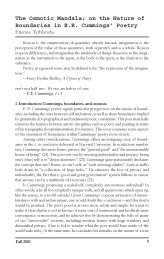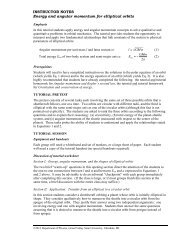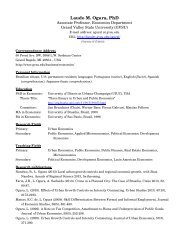The Yin Dynamic in Cummings' Poetry - Gvsu
The Yin Dynamic in Cummings' Poetry - Gvsu
The Yin Dynamic in Cummings' Poetry - Gvsu
Create successful ePaper yourself
Turn your PDF publications into a flip-book with our unique Google optimized e-Paper software.
<strong>The</strong> <strong>Y<strong>in</strong></strong> <strong>Dynamic</strong> <strong>in</strong> Cumm<strong>in</strong>gs’ <strong>Poetry</strong>Etienne TerblancheIIn a 1955 letter to Norman Friedman, Cumm<strong>in</strong>gs writes that the mascul<strong>in</strong>eis superficial and the fem<strong>in</strong><strong>in</strong>e is profound. <strong>The</strong> poet expla<strong>in</strong>s thatthis is so, because the male lover merely th<strong>in</strong>ks of flowers, while the femalelover feels them. If these statements are at once compell<strong>in</strong>g and perplex<strong>in</strong>g,it is at least partially because they go aga<strong>in</strong>st the gra<strong>in</strong> of various overt orcovert assumptions. Perhaps one assumes that th<strong>in</strong>k<strong>in</strong>g is more importantand progressive than feel<strong>in</strong>g, while mascul<strong>in</strong>ity should be dom<strong>in</strong>ant. <strong>The</strong>seand similar assumptions may form an epistemic and ontological complexthat a poet may wish to unravel, expose, or rejuvenate through his or herart.Throughout his engag<strong>in</strong>g 1982 book entitled <strong>The</strong> Turn<strong>in</strong>g Po<strong>in</strong>t: Science,Society and the Ris<strong>in</strong>g Culture, the theoretical physicist and deepecologist Fritjof Capra argues that the mascul<strong>in</strong>e has become too dom<strong>in</strong>ant<strong>in</strong> our progressive societies, to the detriment of the fem<strong>in</strong><strong>in</strong>e and, most importantly,to the detriment of an overall, dynamic culture-nature balance.In a modern English appropriation of Ch<strong>in</strong>ese thought, Capra calls the mascul<strong>in</strong>eforce yang and the fem<strong>in</strong><strong>in</strong>e y<strong>in</strong>. By do<strong>in</strong>g this, he is able to carry theimportant recognition that the fem<strong>in</strong><strong>in</strong>e, or y<strong>in</strong>, is neither passive nor <strong>in</strong>ferior.In fact, he is able to suggest that neither of the two forces are <strong>in</strong>ferior—both are good and necessary, while susta<strong>in</strong>ed humanly-<strong>in</strong>duced imbalancebetween them gives rise to bad results of ill health socially, <strong>in</strong>dividuallyand naturally (Capra 18; see also Palmer 19).To allow a t<strong>in</strong>y wild flower to cont<strong>in</strong>ue grow<strong>in</strong>g <strong>in</strong> accordance with its<strong>in</strong>ner drive as a liv<strong>in</strong>g creature with<strong>in</strong> an immensely conflict<strong>in</strong>g and ultimatelyalso fragile reality called natural existence is as profound and importantas it may be to chop down a tree for fuel and clearance—or economicgrowth. Leav<strong>in</strong>g the flower or the tree to be, and appreciat<strong>in</strong>g its life,is a y<strong>in</strong> action on par with yang actions, such as dry, objective, <strong>in</strong>tellectually-drivenprogress. Capra’s master stroke, as <strong>in</strong> his quite different mannerCumm<strong>in</strong>gs’, is to see gender <strong>in</strong> the context of active wholeness as <strong>in</strong>formedby a Western perception of Ch<strong>in</strong>ese values such as y<strong>in</strong> and yang—I shallreturn to this recognition.S<strong>in</strong>ce progressive societies have susta<strong>in</strong>ed yang-dom<strong>in</strong>ation to the ex-40 Spr<strong>in</strong>g 16
tent of disease and its concomitant dis-ease, part of the solution to the crisisof imbalance, as Capra sees it, is the restoration of y<strong>in</strong> (30). This wouldentail, among other th<strong>in</strong>gs, the active respect<strong>in</strong>g of y<strong>in</strong> qualities, such asdarkness, mud, flexibility, allow<strong>in</strong>g a plant to prosper as a liv<strong>in</strong>g, otherlysoul or self, and so on. If Capra is right about this, Cumm<strong>in</strong>gs has rema<strong>in</strong>edahead of his time, s<strong>in</strong>ce he persuasively provokes one to re-spect(reconsider or look aga<strong>in</strong> at) y<strong>in</strong> values, those supposedly less importantth<strong>in</strong>gs, such as mud (th<strong>in</strong>k of the marvellous neologism “mudluscious” [CP27]), the moon ris<strong>in</strong>g, and so on.Exam<strong>in</strong><strong>in</strong>g Cumm<strong>in</strong>gs’ tendency to restore y<strong>in</strong> values on strategic occasionswill br<strong>in</strong>g about a further critical appreciation of his ability to writea unique modernist poetry of rejuvenat<strong>in</strong>g natural wholeness. Restor<strong>in</strong>g y<strong>in</strong>is therefore only one aspect of a larger picture when it comes to Cumm<strong>in</strong>gs’poetry, but an important and relatively neglected aspect. <strong>The</strong> largerpicture I have <strong>in</strong> m<strong>in</strong>d, I shall term for the sake of a work<strong>in</strong>g def<strong>in</strong>itionCumm<strong>in</strong>gs’ awareness of dynamic wholeness, and his effectiveness <strong>in</strong> convey<strong>in</strong>git. Not only is the poet <strong>in</strong>nately attracted to dynamic wholeness <strong>in</strong>natural be<strong>in</strong>g, but his poems have a concomitant effect: they actively steerthe reader <strong>in</strong>to a sense of wholeness with and with<strong>in</strong> the natural world. Avariety and <strong>in</strong>tensity of devices <strong>in</strong> Cumm<strong>in</strong>gs’ oeuvre serve to fulfil thisvital quality of his poetry, <strong>in</strong>clud<strong>in</strong>g not only the overcom<strong>in</strong>g of opposites,but also the occasionally startl<strong>in</strong>g and direct y<strong>in</strong> restoration to be exam<strong>in</strong>edhere—for example, his <strong>in</strong>sistence that the fem<strong>in</strong><strong>in</strong>e feel<strong>in</strong>g of the flower isprofound, while mascul<strong>in</strong>e th<strong>in</strong>k<strong>in</strong>g about it is superficial.<strong>The</strong> restoration ga<strong>in</strong>s its full impact only upon recogniz<strong>in</strong>g that itforms part of a remarkable and dynamic equilibrium of y<strong>in</strong> / yang values.A good start<strong>in</strong>g po<strong>in</strong>t <strong>in</strong> consider<strong>in</strong>g this is to know that the decisively maleCumm<strong>in</strong>gs enjoyed a fatherly love that set him free to see a necessary balancebetween the male and female worlds of experience. <strong>The</strong> Jungian therapistJames Hollis writes <strong>in</strong> his book Under Saturn’s Shadow: the Wound<strong>in</strong>gand Heal<strong>in</strong>g of Men (1994) that Cumm<strong>in</strong>gs is one of the few sons of his erawho is able to bless his father (99). Quot<strong>in</strong>g the last stanza of “my fathermoved through dooms of love” (CP 521), Hollis says: “<strong>in</strong> the elder’s capacityto live his life fully, he modelled and activated that mascul<strong>in</strong>e potential<strong>in</strong> the son” (99). If we talk about Cumm<strong>in</strong>gs’ y<strong>in</strong> restoration, the paradox isthat one must beg<strong>in</strong> with his mascul<strong>in</strong>e sense of life.To be sure, Cumm<strong>in</strong>gs also encountered various troubles with his father—RichardS. Kennedy has po<strong>in</strong>ted out sensitively and lucidly enoughFall 2007 41
the Freudian aspects of this struggle (102-104). Yet his father also left himwith the deep joy of be<strong>in</strong>g fully mascul<strong>in</strong>e, as “my father moved throughdooms of love” testifies. In a note that Kennedy unearths, Cumm<strong>in</strong>gs summarizesthe situation. He writes that his father was a true father who lovedhim, and because he loved him, Cumm<strong>in</strong>gs was able to love him <strong>in</strong> turn:“first, as a child, with the love which is worship; then, as a youth, with thelove that gives battle; last, as a man, with the love which understands”(quoted <strong>in</strong> Kennedy 103). <strong>The</strong> pattern of this rem<strong>in</strong>ds me of the Zennotion that we may first feel that the mounta<strong>in</strong> is just an extension of ourego, then, <strong>in</strong> grow<strong>in</strong>g up, we may experience it as completely other, andthen we may see the mounta<strong>in</strong> as mounta<strong>in</strong> aga<strong>in</strong>, but <strong>in</strong> active reconciliation.Although the process that Cumm<strong>in</strong>gs sketches <strong>in</strong> a similar threestagedprocess with reference to his father did not work out <strong>in</strong> a neatlyspaced and easy succession, as Kennedy po<strong>in</strong>ts out (103), his perception ofcom<strong>in</strong>g to active reconciliation with his father (with<strong>in</strong> himself) testifies to adeep love that was active <strong>in</strong> our non-hero. It may be my perception only,but this k<strong>in</strong>d of exchange of acceptance and love—at its deepest level anacceptance of the self—has become more difficult to negotiate among fathersand sons s<strong>in</strong>ce then. And if it has become more difficult, at least partof the symptoms or reasons that centre on the difficulty is a distortion of thebalance between fatherly yang and motherly y<strong>in</strong>. In other words: someonewho experiences fatherly love, and perceives distortion between yang andy<strong>in</strong> as a consequence <strong>in</strong> the world around him (or her), will <strong>in</strong> all likelihoodat least wish to restore y<strong>in</strong>. Should such a person be a poet, he or she mayuse the medium to communicate the restoration. As far as I can see, someth<strong>in</strong>gof this nature occurs <strong>in</strong> the remarkable twentieth century case ofCumm<strong>in</strong>gs.<strong>The</strong> best illustrations of fatherly / mascul<strong>in</strong>e love are found <strong>in</strong> theCumm<strong>in</strong>gsian space for which one should care most: his poetic world. Asthe first l<strong>in</strong>e of his fatherly praise poem testifies, the fatherly bless<strong>in</strong>g isradically <strong>in</strong>terdependent with experienc<strong>in</strong>g (and not avoid<strong>in</strong>g or subjugat<strong>in</strong>g)life’s darkness, its y<strong>in</strong> side. His father moves through “dooms oflove”—not through (say) “rays of manly sunsh<strong>in</strong>e” or by means of (say)“bl<strong>in</strong>d<strong>in</strong>gly brilliant ideas of progress.” Rays of manly sunsh<strong>in</strong>e may beimplied, but the way <strong>in</strong> which his father gets to love must be considered.He is moved by, and moves towards, his lov<strong>in</strong>g manl<strong>in</strong>ess through (notsimply despite) an apprehension of <strong>in</strong>tegration: his doom. Evidently this<strong>in</strong>volves an enormous (but actual, not sublime) sense of overwhelm<strong>in</strong>g42 Spr<strong>in</strong>g 16
darkness <strong>in</strong> fear of the unavoidable end of one’s <strong>in</strong>dividual ego or“personhood” after a lifetime on earth. <strong>The</strong> y<strong>in</strong> qualities of darkness and<strong>in</strong>tegration imply that the life force is enormously larger than one’s <strong>in</strong>dividualego, and that it will outlast one—they po<strong>in</strong>t <strong>in</strong>to <strong>in</strong>tegration, and the<strong>in</strong>tegrity that may arise from recogniz<strong>in</strong>g this.And <strong>in</strong> Cumm<strong>in</strong>gs’ praise poem, the father’s love actively connectsmanhood and the darkness of an engulf<strong>in</strong>g doom. In fact, the plural“dooms” suggests that mov<strong>in</strong>g through darknesses is an everyday part of afull life. It is precisely this that makes the father’s love full enough to beconv<strong>in</strong>c<strong>in</strong>g. Cumm<strong>in</strong>gs’ yang as embodied <strong>in</strong> the fatherly love that he <strong>in</strong>herited(actively), and for which his speaker praises the father <strong>in</strong> this poem,results through a full recognition of y<strong>in</strong>—it is very far from an exclusivistyang. It is the very dynamic <strong>in</strong>terplay, balance and connectivity of light anddark aspects, or traditionally male and female qualities, that make the fathera complete and active father. Amidst the immensity of forces that Cumm<strong>in</strong>gssuggests <strong>in</strong> this manner, there is the father’s <strong>in</strong>tegrat<strong>in</strong>g capacity tobe a total human be<strong>in</strong>g and, <strong>in</strong> his case, a man.Powerful as it is, all this means that the father’s wholeness as a man isnon-dom<strong>in</strong>ant: it is not skewed <strong>in</strong> the direction of a “pure,” exclusivist orisolated “mascul<strong>in</strong>ity.” In other words, it is not skewed accord<strong>in</strong>g to a patriarchalworld view <strong>in</strong> which only yang elements must always enjoy the upperhand, usually to the persistent detriment of y<strong>in</strong>. This remarkable nondom<strong>in</strong>ationor democracy blooms <strong>in</strong> the son’s poetry. As Brian Dochertywrites, Cumm<strong>in</strong>gs is able to compose poems of natural sexual love, without“a need to dom<strong>in</strong>ate the other person” (125). One could say that Cumm<strong>in</strong>gsliberates his engagement with the female world, because he feels liberated<strong>in</strong> his mascul<strong>in</strong>ity. It is aga<strong>in</strong>st this background that his y<strong>in</strong> restorationmakes its fuller sense.IIAs has been mentioned, Cumm<strong>in</strong>gs perceives <strong>in</strong> his progressive societya static hierarchy <strong>in</strong> which the sh<strong>in</strong>e and dom<strong>in</strong>ation of a rational (butactually narrow and isolated) mascul<strong>in</strong>ity—a patriarchy—replaces and distortsthe ongo<strong>in</strong>g natural balance. Given the ongo<strong>in</strong>g scale of what someterm an ecological crisis, one must agree at least that humanity, a third pivotalforce of be<strong>in</strong>g along with heaven and earth, has never before <strong>in</strong> historymanaged to distort the natural balance of light and dark forces to such adestructive degree.Although not everyone would agree with a y<strong>in</strong> / yang framework,Fall 2007 43
voices cont<strong>in</strong>ue to say (and s<strong>in</strong>g) that progressive human destruction of thenatural world and process has reached an unhealthy level. (I hasten to add:as a means of poetic precision, I see advantage <strong>in</strong> a y<strong>in</strong> / yang framework.)As the myrmecologist (ant specialist) and evolutionary biologist, EdwardO. Wilson says <strong>in</strong> Biophilia (1984), “human destructiveness is someth<strong>in</strong>gnew under the sun” (122; my emphasis). Wilson writes that <strong>in</strong> ourown brief lifetime humanity will suffer an <strong>in</strong>comparable loss<strong>in</strong> aesthetic value, practical benefits from biological research,and worldwide biological stability. Deep m<strong>in</strong>es of biologicaldiversity will have been dug out and carelessly discarded <strong>in</strong>the course of environmental exploitation, without our evenknow<strong>in</strong>g fully what they conta<strong>in</strong>ed. (122)Not only do we not even know what those slabs of ra<strong>in</strong> forest removedso readily may have conta<strong>in</strong>ed, we will not ever know, either. If we considerthis situation of progressive human abuse of nature—or whatever wewant to call it—not only <strong>in</strong> terms of its crucial physical component, butalso <strong>in</strong> terms of its <strong>in</strong>terrelated and deeper emotional, aesthetic and ethicalterms, Cumm<strong>in</strong>gs spr<strong>in</strong>gs to m<strong>in</strong>d, and so does his y<strong>in</strong> dynamic <strong>in</strong> particular.What Cumm<strong>in</strong>gs sees is that a narrow perception of y<strong>in</strong> has to do, importantly,with narrow, overdriven yang—<strong>in</strong> which an imbalanced, rational“progress” must come at the cost of natural be<strong>in</strong>g. And although earth cont<strong>in</strong>uesto overcome the imbalance, there is no guarantee that she must cont<strong>in</strong>ueto do so <strong>in</strong> the face of an (<strong>in</strong>)humanly-imposed imbalance. Importantly,Cumm<strong>in</strong>gs suggests that narrow y<strong>in</strong> has to do with narrow yang,while this cont<strong>in</strong>ues to re<strong>in</strong>force the narrow<strong>in</strong>g of both. A conform<strong>in</strong>g andstatic monotony of overdriven rational progressiveness bears the brunt ofhis often brilliant satirical poems, such as the sonnet “when serpents barga<strong>in</strong>for the right to squirm” (CP 620). <strong>The</strong> crux <strong>in</strong> that sonnet is thatearth’s creatures rema<strong>in</strong> powefully and wisely spontaneous, <strong>in</strong> the sense ofcont<strong>in</strong>u<strong>in</strong>g to grow <strong>in</strong>to their utter selves. And a certa<strong>in</strong> male spirit (ak<strong>in</strong> toChronos or Saturn, as found for <strong>in</strong>stance <strong>in</strong> Goya’s pa<strong>in</strong>t<strong>in</strong>g “Saturn Devour<strong>in</strong>ghis Son”) imposes the most unnatural grid on life. While treesgrow and thrushes fail to fill <strong>in</strong> forms to justify their song, humans—supposedly so <strong>in</strong>telligent—end up sign<strong>in</strong>g on dotted l<strong>in</strong>es, accus<strong>in</strong>g othersof “altitude,” and so forth.Fortunately Chronos fails to impose his grids, too, s<strong>in</strong>ce earth showsresistance with her spontaneous cont<strong>in</strong>uance which embodies timelessnessrather than a logical imposition of “time.” While a certa<strong>in</strong> male rationalismand / or “religiosity” cont<strong>in</strong>ues to prod and p<strong>in</strong>ch earth for “answers,” she44 Spr<strong>in</strong>g 16
esponds astound<strong>in</strong>gly and simply enough with spr<strong>in</strong>g itself (CP 58).From a poetic viewpo<strong>in</strong>t, the progressive imbalance that takes forgranted the enormous event of spr<strong>in</strong>g—while supposedly “enormous” advancesof all k<strong>in</strong>ds must simultaneously deserve all our attention—shouldbe overturned at the right moments so that the direction towards heal<strong>in</strong>grema<strong>in</strong>s visible. Such overturn<strong>in</strong>g may loosen up a little the yangoverdrivencomplex <strong>in</strong> order to beg<strong>in</strong> to unravel it, for the sake of a greater,more poetic (but neither “vague” nor purely “idealistic”) and more dynamicbalance. And even <strong>in</strong> surpris<strong>in</strong>g moments, for <strong>in</strong>stance at the end of theplayful little drama depict<strong>in</strong>g adultery entitled “may i feel said he,” Cumm<strong>in</strong>gsrestores the y<strong>in</strong> element that we may term <strong>in</strong>clusivity and <strong>in</strong>tegration(as opposed to yang exclusivity and separation), as we see <strong>in</strong> the sudden,capitalized seriousness <strong>in</strong> the f<strong>in</strong>al l<strong>in</strong>e: “you are M<strong>in</strong>e said she” (CP 399).IIII have suggested already that all this has to do not only with Cumm<strong>in</strong>gs’sensibility of fatherly love and joyous mascul<strong>in</strong>ity, but also with hisorientalism. <strong>The</strong> broader context of Cumm<strong>in</strong>gs’ y<strong>in</strong> dynamic—his tendencyto restore y<strong>in</strong> values as part of an overall y<strong>in</strong> / yang balance—is probablyalso Taoist. On other occasions (Terblanche, Ecology), and follow<strong>in</strong>gFriedman’s characterization of Cumm<strong>in</strong>gs as a Zen monk (173), I havedelved <strong>in</strong>to Cumm<strong>in</strong>gs’ textual Taoist lean<strong>in</strong>gs as found <strong>in</strong> his poetry, withsome support and suggestions from his secondary writ<strong>in</strong>gs. Suffice to saythat the attraction that Taoism holds for Cumm<strong>in</strong>gs is part of his poeticwholeness, and must be given all its historical and present poetic significance.It is therefore worthwhile to l<strong>in</strong>ger for a while with the book ascribedto the father of Taoism, Lao Tzu’s Tao Te Ch<strong>in</strong>g. As far as we can discernfrom a text such as this, Lao Tzu equates his natural sensibility on a numberof occasions with darkness, the mother, water, the empt<strong>in</strong>ess of a valley,and so forth. He also laments on one occasion his apparent foolishnessamong men of the world. Men of the world are “bright, alas, so sh<strong>in</strong><strong>in</strong>gbright,”whereas Lao Tzu appears to himself as hav<strong>in</strong>g “the heart of a fool:so confused, so dark” (35). In these moments Lao Tzu confirms the importanceof stat<strong>in</strong>g one’s darkness <strong>in</strong> response to a bl<strong>in</strong>d<strong>in</strong>g and sometimesunhealthy progress. But <strong>in</strong> his case, these s<strong>in</strong>gular statements of actualdarkness also f<strong>in</strong>d their place <strong>in</strong> the larger y<strong>in</strong> / yang process. For <strong>in</strong>stance,he further states that active balance of y<strong>in</strong> and yang with<strong>in</strong> oneself leads tosee<strong>in</strong>g <strong>in</strong> the natural manner of a wise child—an understand<strong>in</strong>g that isFall 2007 45
know<strong>in</strong>g and spontaneous, and a know<strong>in</strong>g at complete ease with be<strong>in</strong>g partof everyth<strong>in</strong>g and be<strong>in</strong>g utterly oneself:Whosoever knows his malenessand guards his femaleness:he is the gorge of the world.If he is the gorge of the worldeternal Life does not leave himand he becomes aga<strong>in</strong> as a child. (Lao Tzu 39)<strong>The</strong> extreme opposites of know<strong>in</strong>g one’s mascul<strong>in</strong>ity (reason, light andvalour) while keep<strong>in</strong>g one’s fem<strong>in</strong><strong>in</strong>ity (<strong>in</strong>tuition, darkness and flexibility)blend <strong>in</strong>to the wise child as one cont<strong>in</strong>ues to f<strong>in</strong>d the way of nature, andlive with<strong>in</strong> it. From a level <strong>in</strong>formed by cont<strong>in</strong>uation or eternity, one seesbeyond merely <strong>in</strong>terfer<strong>in</strong>g concerns of the ego—paradoxically, <strong>in</strong> this mannerthe ego f<strong>in</strong>ds its active and clear place.After his visit to Russia, Cumm<strong>in</strong>gs says that he perceived <strong>in</strong> himself a“dark poet;a bl<strong>in</strong>dman” who is <strong>in</strong> the process of “darkly communicat<strong>in</strong>gwith impossible light” (quoted <strong>in</strong> Kennedy 333). In this lies various realizations:a Taoist acceptance of darkness as part of the life process is one ofthem, just as his father had to move through dooms to live the wholeness oflove.In his mature years he published this poem with its clear Taoist senseof childlike perception with<strong>in</strong> natural cont<strong>in</strong>uation:who are you,little i(five or six years old)peer<strong>in</strong>g from some highw<strong>in</strong>dow;at the goldof november sunset(and feel<strong>in</strong>g:that if dayhas to become nightthis is a beautiful way) (CP 824)This little poem acts as an <strong>in</strong>dication of deeper layers <strong>in</strong> Cumm<strong>in</strong>gs’project. At first glance, it looks dissimilar to the Lao Tzu translation aboutguard<strong>in</strong>g one’s femaleness and know<strong>in</strong>g one’s maleness, and rightly so,s<strong>in</strong>ce we are read<strong>in</strong>g <strong>in</strong> the first place an American and Cumm<strong>in</strong>gsianpoem. Yet Taoist elements <strong>in</strong>form it well. Formally, its “Ch<strong>in</strong>ese” aspect46 Spr<strong>in</strong>g 16
occurs on the levels of blank space, and a crisp freshness of visuallyorientedsigns com<strong>in</strong>g from the blank space. <strong>The</strong>matically, this poem withits emphasis on the word “way” reflects a Taoist perception that yang (day)and y<strong>in</strong> (night) move <strong>in</strong>to each other, reta<strong>in</strong><strong>in</strong>g a dynamic equilibrium ofhuge, conflict<strong>in</strong>g male and female forces. This cont<strong>in</strong>u<strong>in</strong>g equilibrium is asmuch a part of the actual natural process as it may be part of one’s perception:<strong>in</strong> the most brutal and yet also the most fragile sense, natural life cont<strong>in</strong>uesto cont<strong>in</strong>ue. Also: the poem takes this dynamic y<strong>in</strong> / yang givenness<strong>in</strong>to a larger concern: that of grow<strong>in</strong>g old, so that every human be<strong>in</strong>g’s daywill also turn <strong>in</strong>to night when his or her life gives over from be<strong>in</strong>g alive(through dy<strong>in</strong>g) to the doom of death (and re<strong>in</strong>tegration). That it was publishedposthumously <strong>in</strong> 1963 probably re<strong>in</strong>forces this thematic read<strong>in</strong>g.Preceded and followed by bright bird poems—“t,h;r:u;s,h;e:s” (CP 820)and the humm<strong>in</strong>gbird poem (CP 827)—this way is also the way of nature,and of a natural lifetime on earth, so that the “little i” poem embodies acceptanceof the mixture of youth and age with<strong>in</strong> a lifetime on earth. A marvellouspoem about the gold afterglow of sunset [“D-re-A-mi-N-gl-Y” (CP838)] that I read <strong>in</strong> detail elsewhere (Terblanche, Ecology) carries a nearperfecth<strong>in</strong>t of movement at the end of a day giv<strong>in</strong>g over to night, and thelittle-i poem cited here <strong>in</strong>forms the afterglow poem with a rich Taoist contextof acceptance. Both poems focus on yang giv<strong>in</strong>g over to y<strong>in</strong>, and radicalhuman participation, as well as clarity of spontaneous and wise vision<strong>in</strong> this way. One of many pa<strong>in</strong>t<strong>in</strong>gs visible on Ken Lopez’s website (http://www.eecumm<strong>in</strong>gsart.com) shows a t<strong>in</strong>y figure with<strong>in</strong> a mov<strong>in</strong>g landscapeof the gold afterglow as day becomes night—with a remarkable artisticquality of expression, the pa<strong>in</strong>t<strong>in</strong>g rewards study.In these poems and pa<strong>in</strong>t<strong>in</strong>gs, and <strong>in</strong> the little-i poem, Cumm<strong>in</strong>gs h<strong>in</strong>tswith just the right measure of suggestion at a mature, yet also wisechildlike,accept<strong>in</strong>g of the darker, more <strong>in</strong>clusive, and even terrify<strong>in</strong>g dy<strong>in</strong>gside of a lifedeath or a liv<strong>in</strong>gdy<strong>in</strong>g, thus restor<strong>in</strong>g once more y<strong>in</strong> with<strong>in</strong> thecontext of a brighter overall balance.Incidentally, one of the ma<strong>in</strong> aspects that Capra mentions <strong>in</strong> his y<strong>in</strong> /yang critique of the disease with<strong>in</strong> progressive societies is precisely their<strong>in</strong>ability to <strong>in</strong>corporate the fact of dy<strong>in</strong>g <strong>in</strong>to their overall patterns of mak<strong>in</strong>gsense of life: the “matter of death is avoided as much as possible,” hewrites, and “death becomes simply the total standstill of the bodymach<strong>in</strong>e”(145), like a haphazard accident that abruptly ends the sh<strong>in</strong><strong>in</strong>g,climb<strong>in</strong>g l<strong>in</strong>e of a material (but perhaps not very maternal) lifetime—aFall 2007 47
shallow response to the mystery of death. Cumm<strong>in</strong>gs’ view and poetic approachto dy<strong>in</strong>g is far more sensitive to the actual complexities of the matter,as has been shown briefly here.With reference to Cumm<strong>in</strong>gs’ “morality” play Santa Claus, EdithEverson shows how Cumm<strong>in</strong>gs’ concept of death <strong>in</strong>cludes a verbal “dy<strong>in</strong>g”which has “positive value as an experience that is natural to and <strong>in</strong>separablefrom the ongo<strong>in</strong>g process of life” (243)—this is what I have <strong>in</strong> m<strong>in</strong>d withCumm<strong>in</strong>gs’ restoration of the supposedly dark and to-be-avoided y<strong>in</strong> dynamic.Everson also po<strong>in</strong>ts out that Cumm<strong>in</strong>gs has a more negative andstatic employment of a more noun-like death, as embodied with<strong>in</strong> the“conventions of society.” She expla<strong>in</strong>s that Cumm<strong>in</strong>gs believes that “theseoppress the <strong>in</strong>dividual and <strong>in</strong>hibit his <strong>in</strong>tuitive and spontaneous impulses”(243). As we have seen, Cumm<strong>in</strong>gs’ sense of nightfall as positivey<strong>in</strong> with<strong>in</strong> the overall y<strong>in</strong> / yang cont<strong>in</strong>uation <strong>in</strong>deed <strong>in</strong>volves a wise childwho rema<strong>in</strong>s spontaneous even <strong>in</strong> maturity, of which dy<strong>in</strong>g is part, but ofwhich static, death-like constructs of rationalism and progress rema<strong>in</strong> to bedoubted for as long as they appear to suppress the spontaneous and y<strong>in</strong>.That is: for as long as they represent a mascul<strong>in</strong>ity separated from and superiorto the fem<strong>in</strong><strong>in</strong>e, they rema<strong>in</strong> unspontaneous and unable to acceptnature <strong>in</strong> its full-empty dynamism.IV<strong>The</strong> overall sense <strong>in</strong> Cumm<strong>in</strong>gs’ work of the positivity of those forcesthat many may view as purely negative—such as doom, fate, <strong>in</strong>tegration,the night, downwardness, dy<strong>in</strong>g, and so on—fall <strong>in</strong> place aga<strong>in</strong>st this y<strong>in</strong> /yang or Taoist background. Examples range from early poems to later ones.Early: <strong>in</strong> the 1922 volume Tulips & Chimneys lovers are turn<strong>in</strong>g “fatally”<strong>in</strong>to their (<strong>in</strong>nermost) selves (CP 283), and this gives positive value to thenotion of “fate.” In a 1926 poem, the female lover should send life out ofthe poetic speaker and the night “absolutely <strong>in</strong>to” him (CP 303). This refresh<strong>in</strong>glyrestores night <strong>in</strong>to a positive position. In another poem from thetwenties, the speaker states that “this is the pass<strong>in</strong>g of all sh<strong>in</strong><strong>in</strong>g th<strong>in</strong>gs,”and that the soul should “lead us / <strong>in</strong>to the / serious / steep / / darkness” (CP49). An entire 1931 sonnet devotes itself to the positivity of the ocean,moonlight, darkness, twilight and re<strong>in</strong>tegration—all of which move“beyond either,” that is, beyond the static splitt<strong>in</strong>g of rational-relational,dualistic separation (CP 380). Other early poems <strong>in</strong>dicate that humank<strong>in</strong>d“achieves amaz<strong>in</strong>g doom” (CP 352): view<strong>in</strong>g doom positively once more,restor<strong>in</strong>g it to an essential element of a mean<strong>in</strong>gful life. A whole garden of48 Spr<strong>in</strong>g 16
oses bows to the mother figure (CP 353) pay<strong>in</strong>g direct homage to the femaleaspect of existence. <strong>The</strong> “black bod / ies” of trees hide green leaves(CP 355): the poem holds black <strong>in</strong> a positive light for once. A later, “th<strong>in</strong>”poem with<strong>in</strong> 50 Poems (which echoes the still later leaf poem (CP 673)with<strong>in</strong> 95 Poems) gives the exclamation mark to “black” whereas for once“white” receives the question mark (CP 487). Perhaps many would allotthese punctuation marks the other way round? Another poem equates nightwith a Nobody who comes slowly over the town to one’s relief (CP 356).Sometimes entire poems should be read as poetic <strong>in</strong>dications that understand<strong>in</strong>gcomes only with the positive reassessment of the y<strong>in</strong> side of be<strong>in</strong>g:when ra<strong>in</strong> whom fearnot children but menspeaks(among leaves Easilythrough voices womenlike tell<strong>in</strong>gof death love earth dark)and thousandthrusts squirms starsTrees,swift each with itsOwn motion deeply to wickedlycomprehend the <strong>in</strong>nocently Doomedbrief all which somewhere isfragrantly,arrive(whenRa<strong>in</strong> comes;predicat<strong>in</strong>g forever,assum<strong>in</strong>gthe laughter of afterwards—i spirally understandWhattouch<strong>in</strong>g meansor What does a handwith your hair<strong>in</strong> my imag<strong>in</strong>ation (CP 357)<strong>The</strong> poem concludes with the male speaker “spirally” understand<strong>in</strong>gthat just as ra<strong>in</strong> and its “womenlike tell<strong>in</strong>g // of death love earth dark” leadFall 2007 49
to a sense of the eternal (“forever”), so does touch<strong>in</strong>g a woman’s hair <strong>in</strong>one’s imag<strong>in</strong>ation. Understand<strong>in</strong>g “spirally” is to understand f<strong>in</strong>ally, andyet not f<strong>in</strong>ally, because the spiral is <strong>in</strong> process, just as the poem “ends” <strong>in</strong>blank space without a clos<strong>in</strong>g parenthesis. And touch<strong>in</strong>g the woman’s hairis vital: Cumm<strong>in</strong>gs knows that celebrat<strong>in</strong>g y<strong>in</strong> / yang unity would be po<strong>in</strong>tlessunless the celebration enters concrete be<strong>in</strong>g, symbolized <strong>in</strong> his poetryby the lovers. <strong>The</strong> emphasis on “what” (repeated and capitalized) may wellpo<strong>in</strong>t to dy<strong>in</strong>g, s<strong>in</strong>ce the word has the connotation of afterlife <strong>in</strong> Cumm<strong>in</strong>gs’poem “ra<strong>in</strong> or hail” (CP 568). At the very moment of beg<strong>in</strong>n<strong>in</strong>g anew relationship, there is also a k<strong>in</strong>d of dy<strong>in</strong>g of the self or ego. In thesetraditional terms, revitalized by Cumm<strong>in</strong>gs <strong>in</strong> this context, the life processdoes not give mascul<strong>in</strong>e light without fem<strong>in</strong><strong>in</strong>e darkness. In fact, mascul<strong>in</strong>elight turns mean<strong>in</strong>gless and shallow without fem<strong>in</strong><strong>in</strong>e darkness, so thatwhat may have appeared to be merely complementary or logically presuppositionalturns out to be fundamental.Cumm<strong>in</strong>gs does not attempt to restore the ecological <strong>in</strong>nocence ofdarkness only, but also of moisture and flow. One poem suggests that(only) “noone” could be softer than the ra<strong>in</strong> (CP 653): this immense flexibilityof softness is to the speaker the equivalent of his deep respect andlove for the lover. A subsequent poem, “little fish climb through the m<strong>in</strong>dof the sea” (CP 665), associates <strong>in</strong>telligence and upwardness with fluidity,the ocean and sexual flow—and not <strong>in</strong> a strict sense with fixity / solidity /dryness, the sky or Helios. Cumm<strong>in</strong>gs’ non-logocentrism, a topic worthy ofdiscussion <strong>in</strong> its own right, therefore also <strong>in</strong>volves elements of nonheliocentrism.Another <strong>in</strong>dication of how Cumm<strong>in</strong>gs restores the y<strong>in</strong> senseis the relative lunacentric nature of his oeuvre, exemplified by the series ofpoems open<strong>in</strong>g his great little volume No Thanks (1935), a lunacentrism <strong>in</strong>f<strong>in</strong>e balance with a love for the sun. Furthermore, the overall nature ofCumm<strong>in</strong>gs’ oeuvre <strong>in</strong>cludes yang fixities and aridities <strong>in</strong>to a heightenedsense of the flexibilities and <strong>in</strong>deed the motions of nature.Another poem states that ten thousand saharan centuries “are smallerthan a rose’s moment” (683), and this further <strong>in</strong>cludes the notion that real /true time is “neither reasoned nor unreasoned” (683)—it moves on beyondopposites of m<strong>in</strong>d. <strong>The</strong>se th<strong>in</strong>gs <strong>in</strong>dicate Cumm<strong>in</strong>gs’ awareness that thefixity and aridity of deserts and wastelands could be due to an overemphasisof qualities such as the “dry” <strong>in</strong>tellect with its distanc<strong>in</strong>g of oppositionalbent. And that restoration will occur <strong>in</strong> terms of flexibility, natural suppleness,fluidity—y<strong>in</strong> elements. To some extent this places Cumm<strong>in</strong>gs <strong>in</strong>50 Spr<strong>in</strong>g 16
counterpo<strong>in</strong>t with ma<strong>in</strong>stream modernist poetry of Eliot, Pound andYeats—a topic for further discussion.Later <strong>in</strong> his poetic career, <strong>in</strong> a poem published <strong>in</strong> 1958, Cumm<strong>in</strong>gsasserts that the “nowhere” of earth’s night is “prodigious” and “proud,” andthat a mother who has given birth has a silent smile “whose only secret allcreation s<strong>in</strong>gs” (CP 714). Indeed, a Cumm<strong>in</strong>gs poem views spr<strong>in</strong>g (CP 718)—traditionally a yang force—as female. <strong>The</strong> earth (clearly on the y<strong>in</strong> sideof the “equation”) is a person, furthermore, “who can never do wrong,” andthe poetic speaker urges us to do and be <strong>in</strong> the same way (CP 769). Here isthe beg<strong>in</strong>n<strong>in</strong>g of a vital <strong>in</strong>st<strong>in</strong>ct at the heart of the y<strong>in</strong> dynamic: participation<strong>in</strong> existence on earth. This return to earth<strong>in</strong>ess is related to the restorationof ecological balance via the restoration of the y<strong>in</strong>-sense, as found <strong>in</strong>Taoism. As Mart<strong>in</strong> Palmer writes, Taoists <strong>in</strong>dulge <strong>in</strong> “cosmic liturgies” torestore natural y<strong>in</strong> / yang balance when they sense that the balance has beendistorted (23), and Cumm<strong>in</strong>gs’ y<strong>in</strong> dynamic has the f<strong>in</strong>e potential of play<strong>in</strong>ga similar role <strong>in</strong> its uniquely <strong>in</strong>dividualistic and American manner.Another poem <strong>in</strong>troduces a sense of positive “noth<strong>in</strong>gness” by meansof an image of the “the great dim deep sound of ra<strong>in</strong>” (CP 816). Dimness,deepness and ra<strong>in</strong> all belong <strong>in</strong> the y<strong>in</strong> aspect of natural existence, here cast<strong>in</strong> positive light (or the reliev<strong>in</strong>g coolness of shadow on a bl<strong>in</strong>d<strong>in</strong>g day, forthat matter). In this poem y<strong>in</strong> restoration reaches a certa<strong>in</strong> salience: thespeaker goes as far as to state that he feels that “sunlight is…onlyloaned:whereas / night is given(night and death and the ra<strong>in</strong> // are given;andgiven is how beautifully snow)” (CP 816). We have come full circle: this isa variant of say<strong>in</strong>g that mascul<strong>in</strong>ity is superficial and fem<strong>in</strong><strong>in</strong>ity profound,while it is this very recognition that makes snow—with its mixture of maleand female connotations—profound.<strong>The</strong> poem furthermore ends with the notion that spr<strong>in</strong>g is that which“nobody may keep.” We have seen that Cumm<strong>in</strong>gs tends to suggest thepositive where we may allocate the negative, and “nobody” could be meantpositively here. It may well refer to the k<strong>in</strong>d of person who does not seehimself as a too-important “someone”—hence a nobody, also <strong>in</strong> thissense—who suffers less perhaps from <strong>in</strong>terfer<strong>in</strong>g worries and thoughts, andwho therefore can actually keep spr<strong>in</strong>g, precisely by do<strong>in</strong>g noth<strong>in</strong>g about it,but rather by be<strong>in</strong>g with or with<strong>in</strong> it by see<strong>in</strong>g its natural clarity.VAs has been <strong>in</strong>dicated, Cumm<strong>in</strong>gs writes of the beautiful way that dayturns <strong>in</strong>to night (CP 824): part of the Taoist perception is, importantly, theFall 2007 51
manages to do it <strong>in</strong> his poetry, as if with the greatest of ease—and surelythis must be discussed if we wish to discuss a more complete Cumm<strong>in</strong>gs.Consider additional formal arrangements of the restoration. <strong>The</strong>re is arejuvenation of less-emphasized elements of significance, such as the lefthand marg<strong>in</strong> of the poem. Uniquely <strong>in</strong> poetry overall, the humm<strong>in</strong>gbirdpoem opens out to the left <strong>in</strong> the shape of a funnel, thus to re-establish avital l<strong>in</strong>k with the otherness of natural phenomena, such as the humm<strong>in</strong>gbirdand its m<strong>in</strong>ute little art work of a nest (see Webster 107). <strong>The</strong>re isCumm<strong>in</strong>gs’ famous or <strong>in</strong>famous foreground<strong>in</strong>g of visual elements, sometimesabove the audial ground of the poem, someth<strong>in</strong>g that R. P. Blackmurcalls the “s<strong>in</strong> aga<strong>in</strong>st the Holy Ghost” (71), and someth<strong>in</strong>g that JacquesDerrida would have called non-phonocentric, and hence significantlyaga<strong>in</strong>st a ma<strong>in</strong> (logocentric) gra<strong>in</strong> or groove of the progressive West. Comb<strong>in</strong>edwith the tendency to create flow via visual re-arrangements, this nonphonocentrismgoes aga<strong>in</strong>st the direction of what has rema<strong>in</strong>ed <strong>in</strong> the progressiveoutlook of an orig<strong>in</strong>al Father. It goes aga<strong>in</strong>st the gra<strong>in</strong>, <strong>in</strong> otherwords, of an abstract voice-centredness, breath-centredness, and male hierarchy—<strong>in</strong>this way it is perhaps the deepest moment of the formal aspect <strong>in</strong>Cumm<strong>in</strong>gs’ overall y<strong>in</strong> dynamic, although it does not simply exclude voice.VI<strong>The</strong> formal level of the y<strong>in</strong> dynamic therefore alters and renews mean<strong>in</strong>g,and the very directions of mean<strong>in</strong>g. Cumm<strong>in</strong>gs’ flow, his restoration ofthe left hand marg<strong>in</strong>, and his ability to create a sense of mergence with andwith<strong>in</strong> natural be<strong>in</strong>g are therefore far from quietistic moments <strong>in</strong> whichpoetry turns <strong>in</strong>to a k<strong>in</strong>d of weakness or jelly. <strong>The</strong>y are moments that appearsoft but—like water—have the tremendous capacity to change the way <strong>in</strong>which the world appears, besides quench<strong>in</strong>g one’s thirst for mean<strong>in</strong>g. Consider(for example) the first of two moon poems that open No Thanks:mOOn Over tOwns mOOnwhisperless creature huge grOp<strong>in</strong>gnesswhO perfectly whOflOatnewly alOne isdreamestFall 2007 53
oNLY THE MooN oVER ToWNSSLoWLY SPRoUTING SPIRIT (CP 383)<strong>The</strong> moon is noticeably silent: it is a whisperless creature as the poemsuggests. It is a “huge grop<strong>in</strong>gness:” an enormous, climb<strong>in</strong>g movement <strong>in</strong>tonight. Its arrival is not familiar, predictable or even probable: it is an immenseconfirmation of all that is possible, s<strong>in</strong>ce it is perfectly new as itrises aga<strong>in</strong>. <strong>The</strong> speaker evidently knows his moon: even though it risesonce more, it does (somehow) look brand new upon a careful look. Moreover,the moon is all-one and entirely itself: it is alOne. In this <strong>in</strong>stance theupper case alteration serves two or three purposes at once—it highlights theorthographic mim<strong>in</strong>g of the moonshape <strong>in</strong> the letter “O,” it underl<strong>in</strong>es thatthe word “one” (unity) is at work with<strong>in</strong> the word “alone,” and it serves tobreak the word “alone” open to show that it also means all(is)one. In short,it does double or triple work as one sign, show<strong>in</strong>g unity with all and s<strong>in</strong>glenessof be<strong>in</strong>g. <strong>The</strong> <strong>in</strong>dividuat<strong>in</strong>g economy that Cumm<strong>in</strong>gs achieves here isdazzl<strong>in</strong>g.<strong>The</strong> poem creates fertile ground for a unique meditation of dissolv<strong>in</strong>gmovement, a merg<strong>in</strong>g float<strong>in</strong>g and drift. I shall work roughly from thesmaller contexts of this movement to its larger context. <strong>The</strong> first l<strong>in</strong>e playsstrik<strong>in</strong>gly with the iconic “O.” It places a pair of double “O”s at each end oftwo separate, s<strong>in</strong>gle “O”s, suggest<strong>in</strong>g that the moon is able to comb<strong>in</strong>e theseparateness of towns as it beg<strong>in</strong>s to float over them. Cutt<strong>in</strong>g the word“grop<strong>in</strong>g” at the “o” and capitaliz<strong>in</strong>g aga<strong>in</strong> the “O,” Cumm<strong>in</strong>gs achieves asense that the moon is “grow<strong>in</strong>g”—“grO,” implies “grow.” So that the lightand def<strong>in</strong>ition of the moon is grow<strong>in</strong>g, climb<strong>in</strong>g (grop<strong>in</strong>g), establish<strong>in</strong>g itsris<strong>in</strong>g s<strong>in</strong>gularity and its comb<strong>in</strong><strong>in</strong>g capacities at once: movement is thepo<strong>in</strong>t, and the dissolv<strong>in</strong>g of what appears rationally as two or more separateactions—which the moon achieves, and which a poem should not dissect,but follow <strong>in</strong>to its implications.In the first stanza the “O”s also underscore two sets of sounds: [u:] (<strong>in</strong>the word “moon”) on the one hand, and [oʊ] and [au] on the other (<strong>in</strong> thewords “over” and “town”). <strong>The</strong> stanza l<strong>in</strong>ks the [u:] sounds persistentlywith the iconic word “moon,” as if <strong>in</strong> some sort of primitive praise soundtowards it, confirmed <strong>in</strong> a dissolv<strong>in</strong>g of personhood and it-ness with<strong>in</strong> the54 Spr<strong>in</strong>g 16
twice repeated “whO” of stanza 2. And it l<strong>in</strong>ks [oʊ] and [au] sounds withmovements such as the moon appear<strong>in</strong>g “over” towns, and such as themoon grow<strong>in</strong>g and “grO/ p<strong>in</strong>g.” <strong>The</strong>se phonic exclamations or meditationsblend marvellously with the iconic play of the remarkable “O,” giv<strong>in</strong>g theoverall sense that all k<strong>in</strong>ds of movements come alive as the moon rises <strong>in</strong>correspondence with the poem creat<strong>in</strong>g its movement.And as always <strong>in</strong> Cumm<strong>in</strong>gs, one will hardly be disappo<strong>in</strong>ted whenone cont<strong>in</strong>ues to look for those further micro-events on the levels of signmak<strong>in</strong>gwhich cont<strong>in</strong>ue to confirm and carry the movement. By load<strong>in</strong>g theword “flOat” with another iconic upper case with<strong>in</strong> stanza 2, the poem createsa near perfect icon of the actual scene: the round, white ball of moonrises above the l<strong>in</strong>e of horizon, just as the word “flOat” now shows a higherround ball <strong>in</strong> its middle, literally-visually ris<strong>in</strong>g out from the rema<strong>in</strong><strong>in</strong>g,creative co<strong>in</strong>cidence of the word “flat.” <strong>The</strong> l<strong>in</strong>e of the horizon is the “flat”part, of course, and the round “O” of moon aris<strong>in</strong>g from and break<strong>in</strong>gthrough this flatness is the newly appear<strong>in</strong>g moon.In the f<strong>in</strong>al stanza, the moon has grown smaller and brighter—as itdoes <strong>in</strong> a night sky on earth—and Cumm<strong>in</strong>gs shows it by <strong>in</strong>vert<strong>in</strong>g the uppercase and lower case scenario as the stanzas progress. By chopp<strong>in</strong>g upthe f<strong>in</strong>al word “spirit” and accentuat<strong>in</strong>g the blank space, he concludes hisvariations on dissolv<strong>in</strong>g personhood (a personalized perception of nature)and the bright, seem<strong>in</strong>gly self-creat<strong>in</strong>g “it”-hood of natural phenomena andevents by show<strong>in</strong>g that the word “spirit” conta<strong>in</strong>s the “it” or “id” of adream<strong>in</strong>gly float<strong>in</strong>g moon.By focuss<strong>in</strong>g on the lunacentric element of natural existence, whenlight and dark swap roles (darkness becom<strong>in</strong>g more dom<strong>in</strong>ant), and <strong>in</strong> particularby creat<strong>in</strong>g a float<strong>in</strong>g or mov<strong>in</strong>g mergence of human perception andnatural events, Cumm<strong>in</strong>gs is able with the apparent ease of a poetic masterto revitalize the enormous importance of supposedly “lesser” elements andevents. This I have called his y<strong>in</strong> dynamic, of which this moon poem is anexquisite example; by us<strong>in</strong>g the yang procedure of chopp<strong>in</strong>g up our usualgrammar with f<strong>in</strong>e precision, he adds a necessary drive of the (perhaps traditionally)mascul<strong>in</strong>e to the equation, not to mention his ability somehow tomanage all of this without becom<strong>in</strong>g “heavy.”VIIAt its deepest and apparently “darkest,” the y<strong>in</strong> dynamic enacts a poeticmoral: earth matters, the moon matters, and humans come to the necessaryunderstand<strong>in</strong>g of their lives only when they (<strong>in</strong> their <strong>in</strong>dividual man-Fall 2007 55
ners, and <strong>in</strong> maturity) recognize this as fully (or emptily) as possible. ForCumm<strong>in</strong>gs “deathless earth’s <strong>in</strong>numerable doom” (CP 821) is an utteranceof positivity: it is what makes the voice of a little bird—who re-calls or res<strong>in</strong>gsthe speaker back <strong>in</strong>to acceptance of a natural lifetime—the“undaunted guest of dark most downwardness / and marvellously self dim<strong>in</strong>utive”(CP 821). (One could say that this is how he at once works withand escapes from a modernist dialectic.) <strong>The</strong> recognition of liv<strong>in</strong>g with<strong>in</strong>darkness is the dim<strong>in</strong>ishment of self that paradoxically (hence uplift<strong>in</strong>gly)br<strong>in</strong>gs about a moment of the most <strong>in</strong>dividualized self. Aga<strong>in</strong> the discomfortone may sense here probably arises because it goes so precisely aga<strong>in</strong>stthe supposedly <strong>in</strong>dividualistic gra<strong>in</strong> of modern progressive life: perhapsone wants that there should be no darkness greater than the sh<strong>in</strong><strong>in</strong>g (andconform<strong>in</strong>g) <strong>in</strong>dividual!Perhaps one who is part of progressive society today ultimately furtherwants or needs the “little man” of Cumm<strong>in</strong>gs’ poem (CP 393) to stay “fullof an important worry”—a situation that has undeniably led to ill health,literally and spiritually, on all k<strong>in</strong>ds of levels, <strong>in</strong>clud<strong>in</strong>g the natural:little man(<strong>in</strong> a hurryfull of animportant worry)halt stop forget relaxwait(little childwho have triedwho have failedwho have cried)lie bravely downsleepbig ra<strong>in</strong>big snow56 Spr<strong>in</strong>g 16
ig sunbig moon(enterus) (CP 393)Relatively pla<strong>in</strong>ly enough, the poem asks that one should replace clutter<strong>in</strong>gand clogg<strong>in</strong>g worries with clarity of natural awareness: the patternsone’s m<strong>in</strong>d was made for. <strong>The</strong> blank space between the conclud<strong>in</strong>g (butreally open<strong>in</strong>g) words “enter” and “us” is a dynamic, iconic <strong>in</strong>vitation ofearth’s vast and reassur<strong>in</strong>g elements to return <strong>in</strong>to human existence. Butthose isolated verbs (“wait” and “sleep”) roughly at the center attract attention,and they reward attention <strong>in</strong>formed by the y<strong>in</strong> dynamic. I believe theyhave to do consciously or unconsciously with the Taoist notion of nondo<strong>in</strong>g,the paradoxical notion that by do<strong>in</strong>g noth<strong>in</strong>g everyth<strong>in</strong>g falls <strong>in</strong>toplace as if by itself.To put it bluntly: does Cumm<strong>in</strong>gs have <strong>in</strong> m<strong>in</strong>d, by emphasiz<strong>in</strong>g these“relax<strong>in</strong>g” verbs, that one should lead a laid-back, hippie-like life of smok<strong>in</strong>gmarijuana and ly<strong>in</strong>g around? Such notions embody a misconception ofthe sheer dynamism of what Lao Tzu may have <strong>in</strong> m<strong>in</strong>d with non-do<strong>in</strong>g.Rather, it appears that these active verbs po<strong>in</strong>t to the <strong>in</strong>herent dynamism ofnature: moons rise and the trees grow of their own accord, whether onenotices it or not, and this occurs along a way propelled by immense forcesof conflict (such as y<strong>in</strong> and yang). <strong>Y<strong>in</strong></strong>-action or non-do<strong>in</strong>g is to appreciatethis actively, actively not to <strong>in</strong>terfere with the natural flow, and <strong>in</strong>teractivelyto go along with it with<strong>in</strong> one’s (natural) spirit. Non-do<strong>in</strong>g is thereforea profound and necessary action of <strong>in</strong>ner and outer acceptance, a humilityand vitality <strong>in</strong> health. Only ignorance can deny the activity of thisk<strong>in</strong>d of action, and although a flyfisher who forgets his worries while hefeels relax<strong>in</strong>gly and forgetfully one with his surround<strong>in</strong>gs may not wish togive this action a profound and strange-sound<strong>in</strong>g name such as y<strong>in</strong> nondo<strong>in</strong>g,that is probably not a bad name to give to his situation. After all, hecan probably hear the silent s<strong>in</strong>g<strong>in</strong>g of nature for once.In any event, Cumm<strong>in</strong>gs’ little man poem says so brightly that nondo<strong>in</strong>gis necessary for openness to return, also with its conclud<strong>in</strong>g see-saw,spontaneously childlike and maturely appreciative sounds of [I]-[ai] (bigra<strong>in</strong>), [I]-[oʊ] (big snow), [I]-[ʌ] (big sun) and [I]-[u:] (big moon). Compell<strong>in</strong>gly,<strong>in</strong> the latter word we cannot help but notice the two iconic moonsFall 2007 57
there, s<strong>in</strong>ce Cumm<strong>in</strong>gs has prepared this well with the mOOn poem preced<strong>in</strong>gthis by a couple of pages. Also, on the suggestive level of signrepetition, this big moon f<strong>in</strong>ds itself <strong>in</strong> f<strong>in</strong>e equilibrium with the sunny notion(but not a heliocentric notion, that is, not a notion <strong>in</strong> violent favour ofthe sun) of the big sun that enters us.Sensitively and powerfully aware of mascul<strong>in</strong>e and fem<strong>in</strong><strong>in</strong>e sides <strong>in</strong>be<strong>in</strong>g on earth, the poet senses an imbalance, and he goes forth to create apoetry that has enormous potential to rejuvenate a dynamic, fresh, crispbalance. Cumm<strong>in</strong>gs the poet is a bl<strong>in</strong>dman as he says, work<strong>in</strong>g with andthrough darkness <strong>in</strong>to impossible light, <strong>in</strong>deed: the light of what the readerexperiences upon read<strong>in</strong>g English <strong>in</strong>to the revitalization of a natural sensibility,also when it comes to the necessary restoration of what we call y<strong>in</strong>,<strong>in</strong> cautious and necessary reference to Cumm<strong>in</strong>gs and Taoism.— North-West University, Potchefstroom, South Africantljet@puk.ac.zaWorks CitedBlackmur, R. P. [Review of 50 Poems.] Critical Essays on E. E. Cumm<strong>in</strong>gs.Ed. Guy Rotella. Boston: Hall, 1984: 70-72.Blake, William. Selected <strong>Poetry</strong> and Prose of William Blake. Ed. NorthropFrye. New York: Modern Library, 1953.Buber, Mart<strong>in</strong>. Po<strong>in</strong>t<strong>in</strong>g the Way (Collected Essays). Trans. & Ed. MauriceFriedman. New Jersey: Humanities Press, 1990.Capra, Fritjof. <strong>The</strong> Turn<strong>in</strong>g Po<strong>in</strong>t: Science, Society and the Ris<strong>in</strong>g Culture.London: Flam<strong>in</strong>go, 1982.Cumm<strong>in</strong>gs, E. E. Complete Poems, 1904-1962. Ed George J. Firmage. NewYork: Liveright, 1994.Docherty, Brian. “[E.E. C]umm<strong>in</strong>gs.” American <strong>Poetry</strong>: <strong>The</strong> ModernistIdeal. Ed. Clive Bloom and Brian Docherty. London: Macmillan.1995. 120-130.Everson, Edith A. “E. E. Cumm<strong>in</strong>gs’ Concept of Death.” Journal of ModernLiterature 7 (1979): 243-254.Friedman, Norman. (Re) Valu<strong>in</strong>g Cumm<strong>in</strong>gs: further essays on the poet,1962-1993. Ga<strong>in</strong>esville: UP of Florida, 1996.Hollis, James. Under Saturn’s Shadow: the Wound<strong>in</strong>g and Heal<strong>in</strong>g of Men.Toronto: Inner City, 1994.Kennedy, Richard S. Dreams <strong>in</strong> the Mirror: A Biography of E. E. Cumm<strong>in</strong>gs.New York: Liveright, 1980.58 Spr<strong>in</strong>g 16
Lao Tzu. Tao Te Ch<strong>in</strong>g (<strong>The</strong> Richard Wilhelm Edition). Trans. H.G. Ostwald.London: Arkana, 1987.Palmer, Mart<strong>in</strong>. “Ch<strong>in</strong>ese Religion and Ecology.” Spirit of the Environment:Religion, Value and the Environmental Concern. Ed. David E.Cooper and Joy A. Palmer. London: Routledge, 1998: 15-29.Surette, Leon. <strong>The</strong> Birth of Modernism: Ezra Pound, T. S. Eliot, W. B.Yeats and the Occult. Montreal: McGill-Queens UP, 1994.Terblanche, Etienne. E. E. Cumm<strong>in</strong>gs: the Ecology of his <strong>Poetry</strong>. UnpublishedPh.D. thesis, North-West University, Potchefstroom Campus,2002.—. “<strong>The</strong> Osmotic Mandala: the Nature of Boundaries <strong>in</strong> E. E. Cumm<strong>in</strong>gs’<strong>Poetry</strong>.” Spr<strong>in</strong>g: <strong>The</strong> Journal of the E. E. Cumm<strong>in</strong>gs Society 10(2001): 9-22.Webster, Michael. “Magic Iconism: Defamiliarization, Sympathetic Magic,and Visual <strong>Poetry</strong> (Guillaume Apoll<strong>in</strong>aire and E. E. Cumm<strong>in</strong>gs).”European Journal of English Studies 5.2 (2001): 97-113.Fall 2007 59


